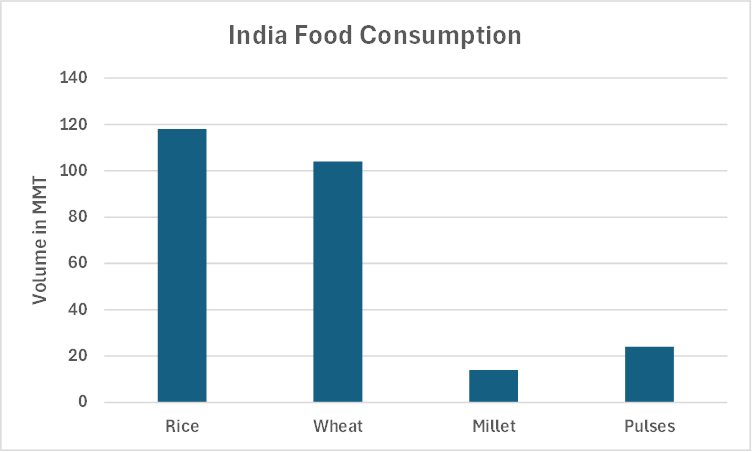India’s Food Consumption
Author
Published
9/16/2024
NOTE: Iowa Farm Bureau is participating in a Governor's Trade and Investment Mission to India organized by the Iowa Economic Development Authority in September 2024. The goal of the mission is to promote and explore mutually beneficial trade and investment opportunities for India and Iowa. Stay tuned for more updates!
Foodgrain Consumption
India’s food consumption is influenced by its diverse culture, religious beliefs, and economic conditions. All of India’s major religions have dietary laws and traditions. For example, Hindus often avoid eating beef, and pork consumption is less common amongst Muslims. Therefore, over 80% of Indian adults abide by some type of meat restrictions, and nearly 40% are vegetarian according to the Ministry of Agriculture & Family Welfare.
Rice is a staple food, particularly in the southern, eastern, and northeastern regions of India. Rice forms the base of many Indian dishes and is often served with lentils, vegetables, or meat. Increasing demand for rice has driven domestic prices higher. India consumes 118 MMT per year (Figure 1).
Wheat is a primary food source in the northern and western regions of India, where it is processed into whole wheat flour (atta) and white flour (maida) and made into chapatis, parathas, puris, and other types of bread. In 2022, India consumed more than 104 MMT of wheat, making it one of the world’s largest consumers of wheat (Figure 1).
Millets are consumed across India, especially in rural areas. Millets consumption has decreased over time as other options have become more readily available. As of 2019, India consumes around 14 MMT of millets annually (Figure 1).
India is the world’s largest consumer of pulses (dried beans, chickpeas, etc.) with nearly 23 MMT annually (Figure 1). Pulses are a critical source of protein for Indian vegetarians.
Figure 1. India Food Consumption
Dairy and Meat Consumption
Meat consumption in India varies widely by region and religious beliefs. Beef is generally avoided due to religious restrictions among Hindus, while pork is less common due to Muslim dietary laws. Chicken is the most widely consumed meat and is often prepared in various forms including curry, tandoori, and kebabs. India consumes over 4 MMT annually (Figure 2).
Carabeef (i.e., water buffalo meat) is one of the most affordable sources of animal protein in India and is a popular option amongst the country’s Muslim and Christian population. Indians consumed over 3 MMT of carabeef in 2022 (Figure 2).
Mutton is often the most expensive meat compared to poultry, fish, and carabeef, which is why its production and consumption are growing relatively slowly. In 2022, India consumed nearly 0.75 MMT (Figure 2). Mutton is still popular in many regions, particularly in northern India where it is used in biryani, curry, and kebabs.
Fish is a cornerstone of the Indian diet and an essential source of omega-3 fatty acids and other necessary nutrients. According to the Indian Council of Agricultural Research, fish consumption increased from 6.5 MMT in 2005 to 14.2 MMT in 2021. Seafood like rohu, hilsa, mackerel, and prawns are common in many foods across India.
Figure 2. India Meat Consumption
Eggs are widely consumed and are an important source of protein. The FAO estimates that the average Indian eats 81 eggs a year. However, there are regional preferences, with 75% of Indian egg production being consumed by the 25% of the population living in urban and semi-urban areas.
India is one of the largest consumers of dairy products. Milk is a dietary staple as it is a chief source of protein for millions of vegetarians. Milk is consumed directly or utilized to make yogurt, buttermilk, paneer, and ghee. Milk consumption surpassed 207 MMT in 2023.
India is one of the world’s leading consumers of tea, with 80% of the tea produced consumed domestically. In 2022, India consumed over 116 MMT of tea.
Fruits and Vegetables Consumption
India has a rich variety of fruits, and consumption patterns vary by region. Mangoes, bananas, apples, oranges, and papayas are among the most popular fruits. Vegetables are an essential part of the Indian diet, with a wide variety consumed across India. Common vegetables include potatoes, onions, tomatoes, okra, eggplant, and spinach. As of 2019, the per capita household fruit and vegetable intake was found to be 15 and 145 grams, respectively. Bananas and potatoes make up a large portion of fruit and vegetable intake.
Regional Breakdown Summary
India is a large, diverse country, but some broad dietary generalities may be helpful to keep in mind:
- Northern India: The diet in the northern part of the country is heavily influenced by wheat, dairy products, and spices. Common dishes include roti, paratha, paneer dishes, and rich curries like butter chicken or dal makhani.
- Southern India: Rice and coconut are staples of dishes like dosa, idli, and sambar in South India. The cuisine tends to be spicier and uses more sour flavors from tamarind and yogurt.
- Eastern India: Rice, fish, and mustard oil are central to the diet of people in the Bengal region of Eastern India, with Bengali cuisine known for its fish dishes and sweets like rasgulla and Sandesh.
- Western India: The diet in the western part of the country varies from the spicy, vegetarian dishes of Gujarat to the seafood-rich cuisine of Maharashtra and Goa. Dishes like dhokla, pav bhaji, and fish curries are popular.
Want more news on this topic? Farm Bureau members may subscribe for a free email news service, featuring the farm and rural topics that interest them most!